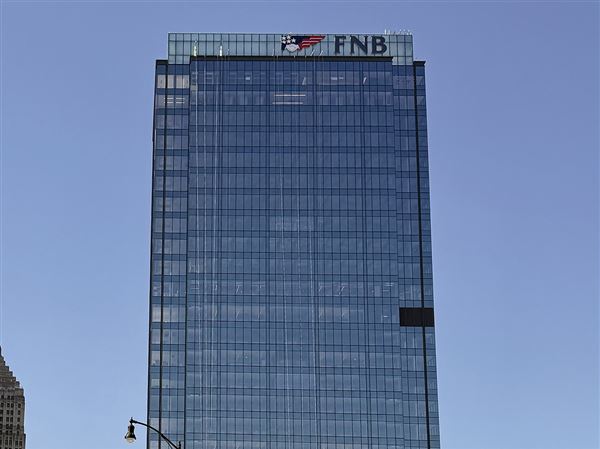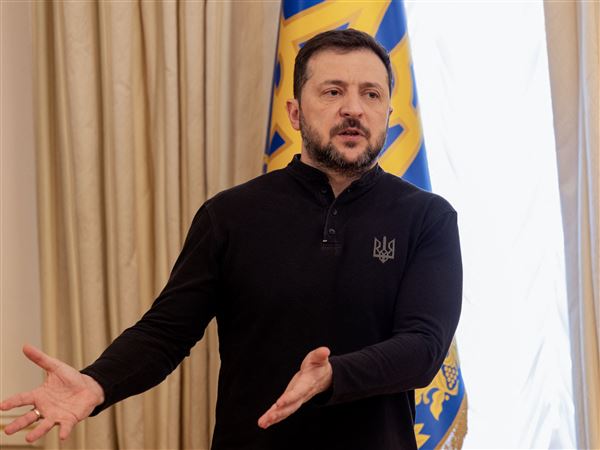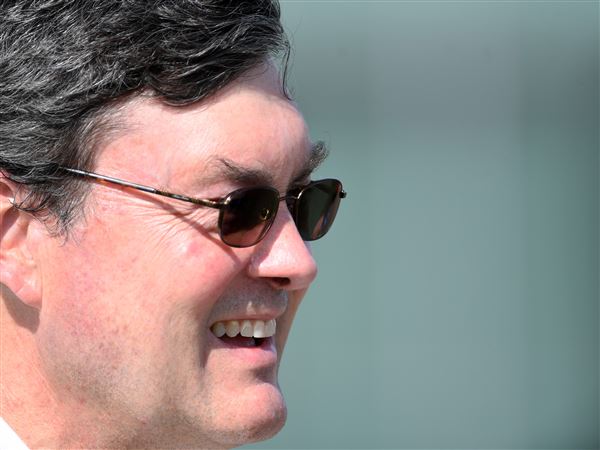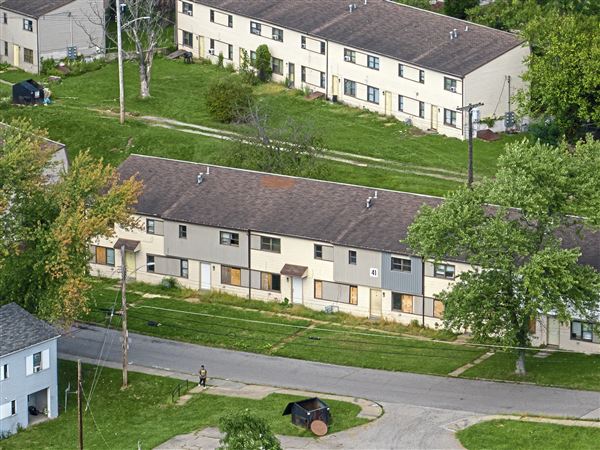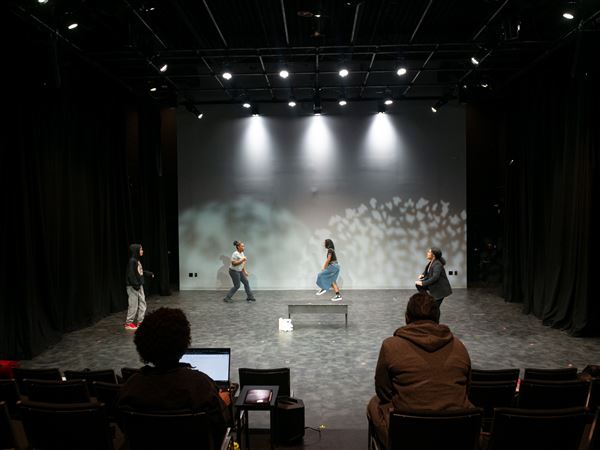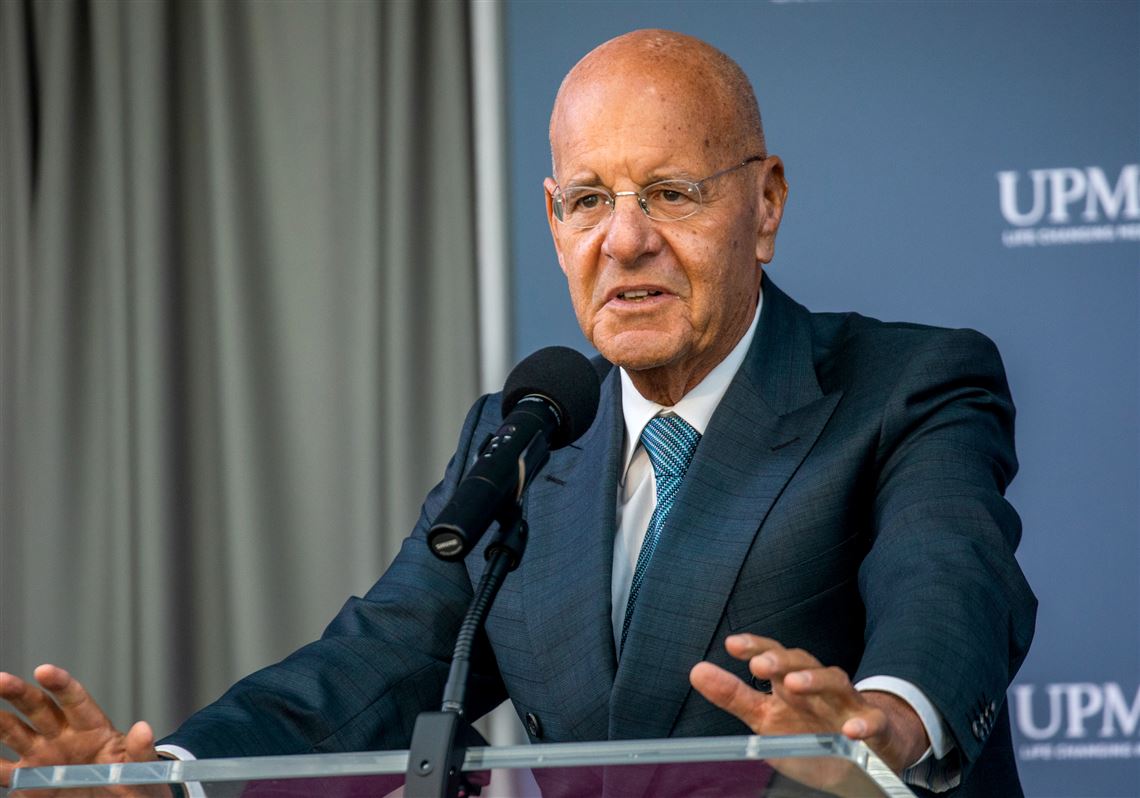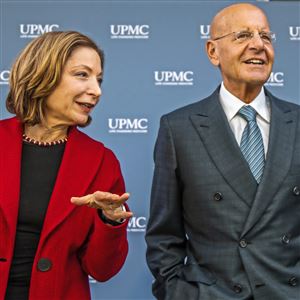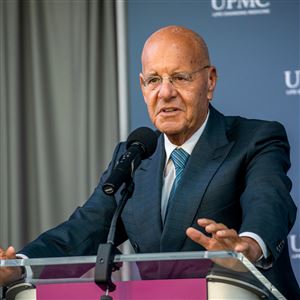Retiring UPMC CEO Jeffrey A. Romoff may best be remembered for his laser focus on growth during a career lasting 48 years at UPMC, an era when the ashes of heavy industry were refashioned into an educational and health care mecca.
But response to the planned departure of the 75-year-old executive from the $23 billion organization that has sprawled into international markets and became the state’s largest non-governmental employer reflected the conflicted relationship that UPMC and its leader seemed to have with its hometown.
Plaudits for Mr. Romoff came from some government officials, while others celebrated change at the top of the powerful organization. Union leaders who have been battling over pay and other issues expressed hope that a new chief executive will be more responsive. Admiration came from businesspeople who recognize it’s not easy to build a behemoth like UPMC.
Mr. Romoff announced his retirement Wednesday. Leslie C. Davis, 62, takes over as CEO of the health system and insurer Sunday.
The executive who stayed with the same employer since 1973 had no lack of ambition, both adapting to the market winds and changing health care delivery as Western Pennsylvanians know it.
The pace of growth didn’t slow in recent years either. Under Mr. Romoff’s leadership, UPMC’s growth surged with the acquisition of seven hospitals in 2016 and seven more hospitals the following year, stretching the organization over to Central Pennsylvania and Harrisburg and up into New York. In 2016, UPMC also announced plans to build a hospital in South Fayette, but those plans were scrapped in the face of community pushback.
In 2017, UPMC unveiled plans to spend $2 billion to extensively rehabilitate two existing hospitals in Oakland and Shadyside, and build a 300,000-square-foot vision and rehabilitation tower on the UPMC Mercy Hospital campus in Uptown, the only one of three planned facilities that’s under construction.
“UPMC seeks to be the Amazon of health care,” Mr. Romoff told reporters at the time with a wide smile.
In fact, UPMC’s house afire growth may have been matched only by the Allegheny Health Network predecessor organization — the Allegheny Health, Education, Research and Education Foundation — which snapped up nine hospitals and medical colleges in the Philadelphia area starting in the late 1980s. But AHERF’s rapid expansion, funded by heavy borrowing, imploded in a massive bankruptcy in 1998.
Mr. Romoff carefully avoided his rival’s financial missteps while stoking growth at UPMC by hiring away AHERF’s oncologists and surgeons. Along the way, his blunt, no-filter approach ruffled feathers.
“You know what your problem is,” Mr. Romoff once told a subordinate hospital executive who asked not to be identified. “Your people don’t fear you.”
State Rep. Dan Frankel, D-Squirrel Hill, was among those who tangled with Mr. Romoff as the UPMC expansion machine roared into high gear. He welcomed word of Mr. Romoff’s retirement Wednesday, saying that during Mr. Romoff’s career, “We’ve seen what it looks like when revenue targets drive decision making.”
“For too long, UPMC has used its strength and expertise to extract from our community — whether that’s the labor of employees who had to rely on the hospital food banks, the silence of doctors fearful of speaking out in case they lost their jobs, or the hard earned dollars of patients desperate for care,” he wrote in a statement. “Perhaps now the institution can become the leader it promised when it posted its logo in the brightest possible lights on top of the Steel Tower: Stop taking and start giving back.”
State Rep. Ed Gainey, the Democratic nominee for Pittsburgh mayor, took a similar scolding tone, saying that the people fueled UPMC’s growth through premium payments and tax subsidies and that it should pay its fair share back to the community.
UPMC said it has provided $6.2 billion in IRS community benefits over the past five years.
Mr. Romoff’s $9 million salary, set by the UPMC board, was dwarfed by the billions in revenue the health care system earned while he was at the helm, but he was scorned and envied by many who felt his compensation was excessive at a nonprofit organization.
Former U.S. Treasury Secretary and Alcoa CEO Paul O’Neill had harsh words in a May 2019 interview about the UPMC hospital chain’s split with crosstown rival Highmark. Mr. O’Neill, who died in April 2020, had quit UPMC’s board of directors after 18 months. He was critical of the CEO’s move to block medical care from individuals on the basis that they didn't have the right insurance card.
But former Highmark CEO Ken Melani, who struggled to keep relations between the Blue Cross Blue Shield insurer and hospital giant from unspooling in 2013 with the expiration of the contract for services between the two Pittsburgh organizations, was more charitable, saying the two men enjoyed a “symbiotic relationship” and “found a way to work together” despite their highly publicized differences.
“We had mutual respect for each other,” Dr. Melani said. “At the time, we didn’t see eye to eye, but in the end, we found a way to work together and create two health care leaders in the nation. The value created for this community is incredible.”
Downtown businessman Robert Fragasso shared Dr. Melani’s sentiment, saying he admired what Mr. Romoff has accomplished, although he’s aware that the health care visionary has been criticized for being tough.
“That’s personal style. Sometimes you have to be tough,” said Mr. Fragasso, CEO of Fragasso Financial Advisors. “But you’ve got to look at the total of a man’s contribution to the enterprise and the community. He deserves congratulations for a job well done.”
Mr. Romoff’s career at UPMC wasn’t all successes.
In a rare misstep, he pulled out of bidding for a federal contract to build a vaccine development and production facility in Pittsburgh at the last minute in July 2011 after investing millions in the project over eight years. UPMC had widely touted its idea for a vaccine factory, which it said would create 1,000 direct and 6,000 indirect jobs.
UPMC’s wholly owned subsidiary, 21st Century Biodefense, dropped out of the bidding because it “would greatly increase the risks to UPMC,” Robert Cindrich, 21st Century Biodefense chairman said at the time.
U.S. Rep. Mike Doyle, a Democrat from Forest Hills and a champion of the vaccine factory in Congress, estimated UPMC’s investment in the project at $20 million. The figure was not confirmed by UPMC officials.
In a 2005 interview with the Post-Gazette, Mr. Romoff said he wanted to make new medicines and other health care innovations replace the steel industry in Pittsburgh, an eds-to-meds transition in an economy once dominated by heavy industry. In a statement Wednesday, Allegheny County Executive Rich Fitzgerald said he was grateful to Mr. Romoff.
“His pioneering enterprises have developed a true medical and life science ecosystem that has benefitted those of us who live in southwest Pennsylvania,” Mr. Fitzgerald wrote in a statement.
“Much of our economic diversity after the collapse of the steel industry began with eds and meds beginning to grow here. Thank you, Jeffrey Romoff, for your contributions to our community.”
Mr. Romoff was not available for comment Wednesday beyond remarks made in a note sent to employees. “We transformed the economy in Western Pennsylvania and turned the world’s eyes to Pittsburgh as a hub of medical innovation and groundbreaking patient care,” he wrote.
In the 2005 Post-Gazette interview, he described himself as a private person.
“I am not a public person,” Mr. Romoff said then. “Intentionally so.”
Kris B. Mamula: kmamula@post-gazette.com. Tim Grant: tgrant@post-gazette.com.
First Published: July 29, 2021, 9:05 a.m.
